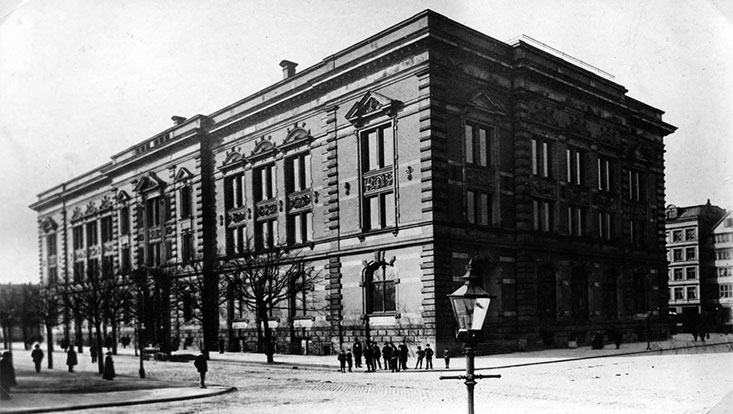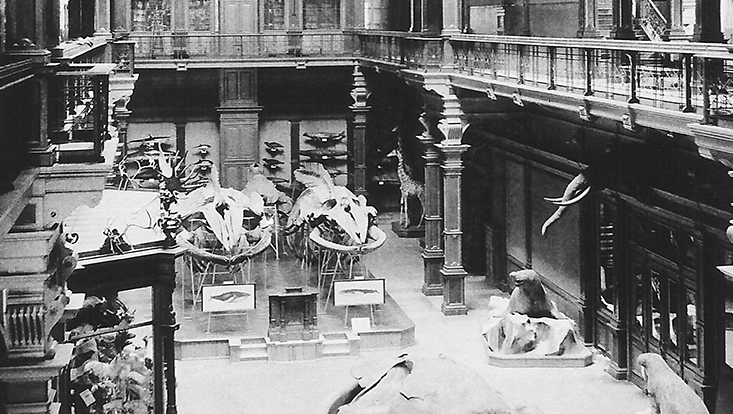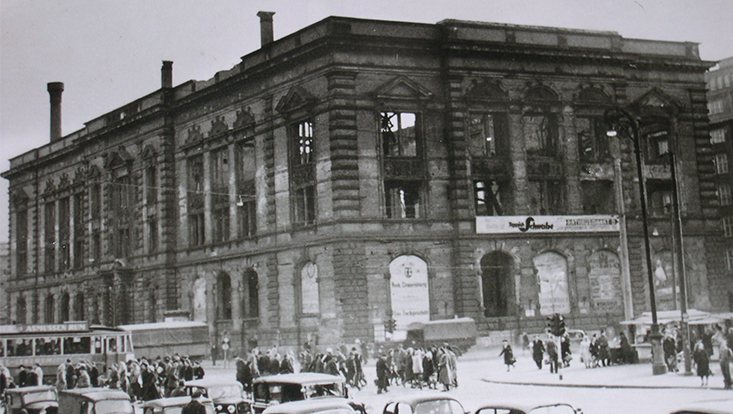History
From the Natural History Museum to the Evolutioneum
The Natural History Museum in the centre of Hamburg was once the second largest natural history museum in Germany - and the most visited. It was an impressive Wilhelmine building with a spacious inner courtyard, several storeys, galleries all around and cantilevered bridges. A passion for collecting was the basis of this exhibition, which was assembled by captains flying the Hamburg flag from all over the world. The building was destroyed during the Second World War and the museum was never rebuilt. In 1969, the city of Hamburg transferred the surviving collections into the possession of the university.
Popular Museum of Natural History

This natural history museum had been founded exactly one century earlier, in May 1843, by Hamburg citizens and found new, adequate premises in the new building on Steintorwall near the main railway station on 17 September 1891.
Objects from all over the world

A passion for collecting was the basis of this exhibition, which was brought together from all over the world by captains flying the Hamburg flag. Among them was what the Hamburg shipowner Johan Cesar VI Godeffroy (1813-1885) brought back from voyages to the South Seas and what the merchant and naturalist Peter Friedrich Röding (1767-1846) displayed in his "Museum for Objects of Nature and Art". Fin and humpback whales, the skeleton of a blue whale and a Steller's giant manatee, already extinct in the 18th century, as well as elephants, monkeys and rhinos were among the main attractions.
Destruction in war

In 1943, a firestorm put an end to this great display of animals from all over the world. Allied bombing raids on Hamburg's city centre during the so-called Operation Gomorrah reduced the house and with it a large part of the important natural history treasures to rubble. Fortunately, parts of the collection were saved. The extensive alcohol collection survived the firestorm in empty underground shafts, the bird collection in a castle in Saxony. Hamburg's Mona Lisa, a unique narwhal skull with two teeth dating from 1684, was saved by a taxidermist, walled up in a cellar room in the middle of the museum. Today, in the zoological exhibition of the Museum der Natur Hamburg, the narwhal is a reminder of the great past times of a Hamburg temple of knowledge in the natural sciences.
It was not until 1951 that the ruins of the old Natural History Museum were demolished. Today, an electrical goods store stands in its place. In 1969, the city of Hamburg transferred the preserved collections into the possession of the university. Slowly they grew again and are now among the most important scientific collections in Germany. But there is no adequate building to house the many millions of objects with a contemporary exhibition.
Centre for Natural History and LIB
More information on the most important milestones on the way to Hamburg's new natural history museum - such as the founding of the Centre for Natural History (CeNak) in 2014 and the merger with the Koenig Museum in Bonn to form the Leibniz Institute for the Analysis of Biodiversity Change (LIB) in 2021 - can be found in the milestones (in German).
175 Years Natural History Museum Hamburg:
Interview with Prof. Dr. Matthias Glaubrecht in Newsroom of the University of Hamburg (in German)
More about the history of the Museum der Natur Hamburg:
Susanne Köstering (2018). Ein Museum für Weltnatur: Die Geschichte des Naturhistorischen Museums in Hamburg (Abhandlungen des Naturwissenschaftlichen Vereins in Hamburg). Herausgeber: Dölling u. Galitz; 1. Edition (18. Mai 2018), Taschenbuch: 344 Seiten.
Matthias Glaubrecht (2018). Back to the future: The Centrum für Naturkunde on its way toward reestablishing a Natural History Museum in Hamburg. – In: Beck, L. A. (ed.), Zoological Collections of Germany – The Animal Kingdom in its Amazing Plenty at Museums and Universities, pp. 435-461. Springer International, Cham.
To the PDF >


